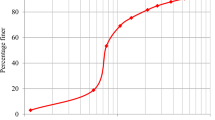Conclusions
Waste from the production of electrotechnical periclase consists of high-quality material with a concentration of 98% magnesia, heat processed at different temperatures with Δmcalc of note more than 0.3%. In order to organize the complete waste-free production of electrotechnical periclase its waste should be used for making periclase-carbon concrete articles using the technology developed by the East Institute of Refractorires. Experimental periclase-carbon articles prepared at the Experimental factory of the Institute were tested in the lining of a 100-ton electric steel-melting furnace at OKhMK; they showed the same resistance as fired PKhS articles.
Similar content being viewed by others
Literature cited
L. B. Khoroshavin and V. A. Perepelitsyn, et al., Ogneupory, No. 10, 35–39 (1988).
A. A. Fedotov, Technical-economic Problems in Waste-free Production in Metallurgy [in Russian], Metallurgiya, Moscow (1980), p. 192.
L. N. Aksel'rod, D. E. Denisov, Yu. V. Materikin, et al., Ogeneupory, No. 1, 38–40 (1987).
Author information
Authors and Affiliations
Additional information
Translated from Ogneupory, No. 11, pp. 13–16, November, 1988.
Rights and permissions
About this article
Cite this article
Khoroshavin, L.B., Perepelitsyn, V.A., Boriskova, T.I. et al. Periclase-carbon articles made from production waste obtained from electrotechnical periclase. Refractories 29, 667–671 (1988). https://doi.org/10.1007/BF01280332
Issue Date:
DOI: https://doi.org/10.1007/BF01280332




